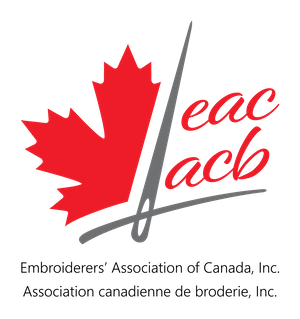Rosemary Marchant was the EAC/ACB’s Speaker Series speaker in October 2024. Rosemary is a member of the Toronto Guild of Stitchery, an Ontario EAC/ACB chapter, and has taught a number of workshops in Ontario. She holds a Technical Certificate in Hand Embroidery from the Royal School of Needlework, UK. In addition to her skills in embroidery, Rosemary coaches students applying to Canadian medical schools.
When I signed up for the lecture, I was thinking of the Bayeux Tapestry and the Overload Embroidery and to be honest, I hesitated! While I have enjoyed visiting the Overlord Embroidery in Portsmouth as well as the All Saints Millennium Tapestry in East Meon, I was not sure about a lecture, having been to a very dry lecture on the Bayeux Tapestry with my grandmother some years ago. I am so glad I did attend this one was so interesting!

Rosemary’s lecture included embroideries that tell a story, not those that are a story about making the embroidery. Rosemary’s presentation broke these narrative embroideries into groups according to the subject of the narrative. This provided me with a framework to consider the stories told as well as the images and techniques; I have included links to some of the tapestries she discussed. She covered war tapestries (the Jersey Occupation Tapestry and Trudie Strobel’s Holocaust embroidery “Russia 1942”). She then moved on to discuss embroideries about place (the French Shore Tapestry), people (the Scottish Diaspora Tapestry), protest (Chilean Arpilleras), those that are a reflection of a specific period (the pandemic lockdown By You Tapestry), and finally those made for promotional purposes (Game of Thrones Tapestry). For each of these topics, she shared photos and facts about a number of embroidered pieces, including who made them, why, when, techniques and materials. It was interesting to see embroideries from different cultures and periods, all united by their purpose of telling their story.
Rosemary showed us stitched and quilted tapestries. Some are a long strip with a border, such as the Bayeux Tapestry, which has mythical creatures embroidered in the borders and brief Latin text explanations in the main panels. Others are stitched panels that were assembled into a rectangle or square more like a quilt. Narrative embroideries vary widely from surface stitching to a combination of quilting, piecing, embroidery and painting. Some tapestries are stitched on clothing. Others are sculptures – The Dinner Party by Judy Chicago is a multi-part sculpture with embroidered table runners on a large, open triangular table. Each runner is set with a matching plate, chalice and utensil celebrating an important woman in history. My perspective on the meaning of the words “narrative embroidery” and “tapestry” has shifted dramatically! These works describe how people, over time, have used fibres to store memories, tell stories and share experiences with others.
I also found it interesting to hear how these different works of art came to be. The ones I was familiar with were commissioned by the aristocracy or religious leaders. However, Rosemary explained that narrative embroideries are also made by ordinary people who want to record something important to them through stitching, sometimes with text to help tell their story. Some groups were encouraged to use stitching, a skill they already knew, to make narrative pieces to help raise awareness of their situation or raise funds for their community (Hwong Story Cloths). In some cases, one person created the narrative work while others are the work of many hands, or they create a set of pieces that, seen together, have an impact greater than the individual panels or designs.
Following the lecture, I was sent a photograph of Marcella Pedersen’s Covid-19 – Memories of 2020 embroidery. Her embroidery tells me she is Canadian (yes, she is an EAC/ACB member!) and that many of her Covid experiences mirror mine. Her story makes me smile with the roll of toilet paper, the hand sanitizer, hands being washed, and Zoom. The words remind me of the ways many people came together to help each other through that difficult time.

2022 Original Design Award (NP) Winner
Throughout Rosemary’s lecture I discovered new ideas and new artists to explore. I’ve provided links to allow you to explore this art form. However, some tapestries are on permanent display. I will try to see two Canadian tapestries next time I am in Ontario:
- The Toronto Historical Embroidery is displayed in the lower rotunda of Toronto City Hall. It was designed by Barbara Gordon and stitched by members of the Toronto guild, who completed it in 1984.
- Our EAC/ACB Canadian Embroidery Tapestry, celebrating Canada’s 150 anniversary as a country, hangs in Rideau Hall as part of Canada’s Crown Collection. It was completed in early 2019 and is the work of over 650 Canadians from across the country.
Rosemary also provided a handout to help us in planning our own narrative embroideries. The handout suggests what to think about, questions to ask, design principles to consider and types of materials that one might use. I am now wondering if there is perhaps an embroidery project I can contribute to, perhaps as a fundraiser or to help document a significant event or time. In the longer term, her handout will be a helpful reference when I am designing my own embroideries. Perhaps I will even design my own narrative embroidery – if I do, I’ll have to send Rosemary a photo!
Written by Ann McDowall, Virtual Threads
Ann is a member of Virtual Threads Chapter of EAC/ACB, CyberStitchers Chapter of EGA and the CyberPointers & San Bernadino CA Chapters of ANG. She is an engineer in the energy industry focused on physical asset management and regulation.


Really wonderful write up. I am sorry I missed this Speaker series.